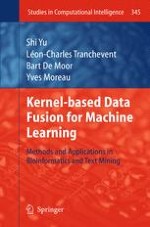Data fusion problems arise frequently in many different fields. This book provides a specific introduction to data fusion problems using support vector machines. In the first part, this book begins with a brief survey of additive models and Rayleigh quotient objectives in machine learning, and then introduces kernel fusion as the additive expansion of support vector machines in the dual problem. The second part presents several novel kernel fusion algorithms and some real applications in supervised and unsupervised learning. The last part of the book substantiates the value of the proposed theories and algorithms in MerKator, an open software to identify disease relevant genes based on the integration of heterogeneous genomic data sources in multiple species.
The topics presented in this book are meant for researchers or students who use support vector machines. Several topics addressed in the book may also be interesting to computational biologists who want to tackle data fusion challenges in real applications. The background required of the reader is a good knowledge of data mining, machine learning and linear algebra.
